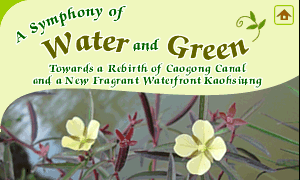Our teacher and our class paid a visit to the Publics Works Bureau of Kaohsiung, in order to have a better understanding of the basic concepts of the Wetland Ecological Corridor. Miau Jen Wang welcomed and gave us a brief introduction on the issue when we arrived. She also answered many questions in detail for us. |
Q1¡GWhat exactly is a Wetland Ecological Corridor about? |
A¡GAs everyone knows, wetlands are rich in various ecosystems. If we link adjacent wetlands together via water or streams, then the organisms from different areas can interact with each other. The connections between them would seem like pathways for them to come and go from one place to another. This is how we developed the concept for a Wetland Ecological Corridor. |
Q2¡GDoes Kaohsiung have suitable conditions for developing a Wetland Ecological Corridor? |
A¡G
Kaohsiung City itself used to be a large lake. Yet due to urban development and gradual accumulation of sand, a few places that used to be aqueous were filled and became land for commercial use. The good news is there is still a lot of wetlands in Kaohsiung, which means there will be no problem if we launch the project here.
Most of Kaohsiung's wetlands are not natural, they're reconstructed. Land is constantly being developed, lakes are being filled up, and this is why currently people are stressing the importance of reconstructing the wetlands. For instance, the first reconstructed wetland in Kaohsiung is located at the Museum of Fine Arts area. Of course, it was hard to find the right place for reconstruction, because real estate prices are high in Kaohsiung. When reconstruction is over, sufficient resources will be needed for its management. We hire people to protect the place, or the wetland could be polluted or even destroyed by man. In the near future, sand precipitation or land fills will be problems to face.
|
Q3¡GWhere are the current locations for reconstruction of Wetland Ecological Corridor of Kaohsiung City¡H |
A¡GThere currently are seven Ecological Corridor projects; some have already been on the move. These seven wetlands are Yuanjhong Port Wetland, Banping Lake Wetland, Chouchai Wetland, Neiweipei Wetland, Banhe Village Flood Detention Pond, Jhongdu Love River Wetland, and the Yanshuei Harbor Wetland. |
Q4¡GWhen the wetland is under construction, is it possible that we destroy the original environment¡H |
A¡GThe environment will be destroyed more or less, but for now we try to keep it as low as possible. Before the construction kicks off, many investigations and plans have been conducted. When the construction is finished, we also try to protect and maintain it. |
Q5¡GWere there any difficulties during the construction process? |
A¡GYes, there were for sure. Although the plan was excellent, accidents still happened. We tried our best to cope with them and took them as a learning experience. Then we will know how to prevent them from happening in the future. |
Q6¡GHow can we maintain this ecosystem? |
A¡GWell, that's a broad question. In short, do not free animals into the wild. That kind of behavior will destroy the conservation projects and contaminate the eco-system . |
Q7¡GWhat can we do to help protect the partially destroyed wetlands? |
A¡GWe call for volunteers to help us assist the maintenance work. When we finish cleaning up the pollution, they will be open for all citizens to visit. |
Q8¡GIs there anything we should do when we enter the wetlands? |
A¡GTalk softly with your voice down. See with your eyes, but do not touch with your hands. Do not litter or free animals into the wetlands. |
Q9¡GHow long will the construction take? |
A¡GThe first phase of Yuanjhong Port wetlands will be finished next year, but mostly it depends on whether we have sufficient funds. |
Q10¡GIf you encounter problems during construction, how do you handle them? |
A¡GWe have intricate engineering techniques to deal with these matters. |
Q11¡GIs there any destruction to the Kaohsiung wetlands currently¡H |
A¡GYes, there is. Some are from construction, but most are from intentional human damage. |
Q12¡GHas Kaohsiung county participated in this project? |
A¡GNo. |
Reflection
 The visit we paid today let me realize the priceKaohsiung City had to pay for developing its industries since so many natural habitats were sacrificed. Thankfully, people are now looking into this problem and trying hard to solve it. I understood the importance and hardships of reconstructing these wetlands during this meeting,and how much planning work had to be done before anything could get started. It is such a difficult, yet a great achievement that a wetland used to contain only a dozen species of birds has been breeding up to 100 species. So, wherever wetland or natural habitat you go, please throw the trash into trashcans, and do not free your animals into the wild. Be responsible. The visit we paid today let me realize the priceKaohsiung City had to pay for developing its industries since so many natural habitats were sacrificed. Thankfully, people are now looking into this problem and trying hard to solve it. I understood the importance and hardships of reconstructing these wetlands during this meeting,and how much planning work had to be done before anything could get started. It is such a difficult, yet a great achievement that a wetland used to contain only a dozen species of birds has been breeding up to 100 species. So, wherever wetland or natural habitat you go, please throw the trash into trashcans, and do not free your animals into the wild. Be responsible.
|

